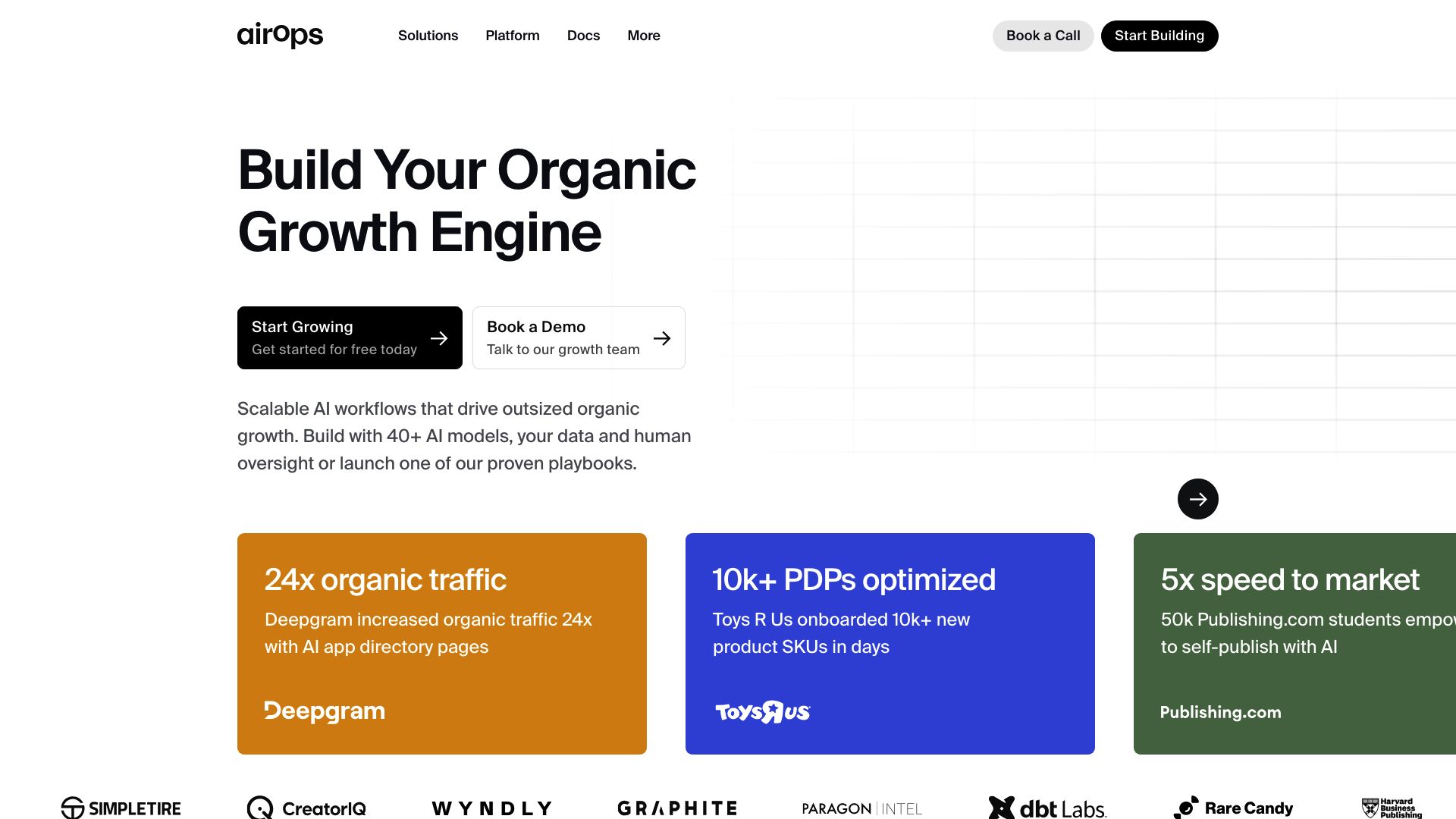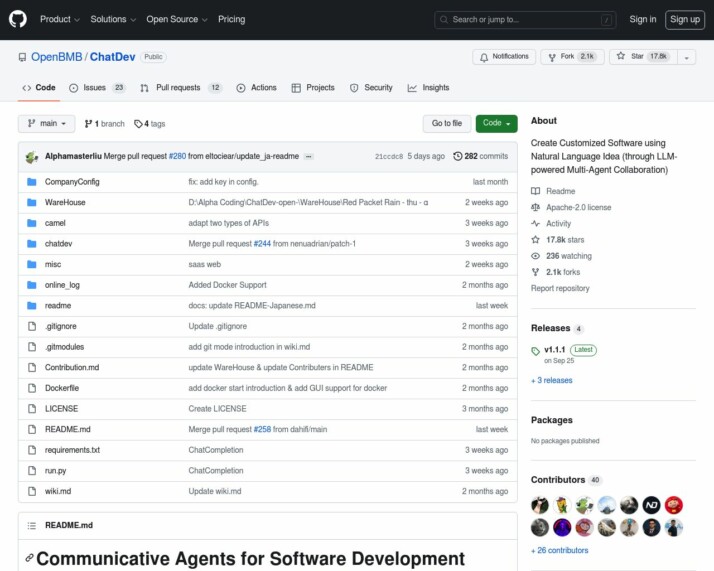AirOps vs. ChatDev: Comparing AI-Driven Development Platforms
AI-driven software development platforms are reshaping how businesses create, optimize, and scale their digital solutions. AirOps vs. ChatDev represent two innovative approaches to this challenge, each offering unique capabilities to streamline workflows and boost productivity. This comparison delves into the strengths and limitations of both platforms, exploring their core features, integration capabilities, and potential impact on various industries.
By examining these cutting-edge tools alongside SmythOS, we’ll uncover how each platform addresses the evolving needs of developers, business leaders, and AI enthusiasts alike. Whether you’re seeking to automate complex workflows, simulate entire development processes, or find a versatile solution that combines the best of both worlds, this analysis will equip you with the insights needed to make an informed decision in the rapidly advancing landscape of AI-powered software development.
AirOps Overview
AirOps empowers businesses to create scalable AI workflows that drive organic growth and optimize operations. The platform integrates over 40 AI models, allowing users to build custom workflows that leverage their own data and incorporate human oversight.


AirOps stands out with its proven playbooks for SEO optimization, product listing management, and content creation. These pre-designed workflows have demonstrated significant results, such as Deepgram’s 24-fold increase in organic traffic. The platform’s flexibility allows integration with various tools and data sources, accommodating text, image, and transcription models alongside data retrieval and human review steps.
AirOps stands out with its proven playbooks for SEO optimization, product listing management, and content creation. These pre-designed workflows have demonstrated significant results…
A key offering from AirOps is the AI Data Sidekick, a tool designed to enhance the efficiency of data practitioners. It assists in writing, optimizing, and troubleshooting SQL queries, as well as building Python models. The AI-powered recipes within this tool are accessible across multiple platforms, including dbt Cloud, Snowflake, Amazon Web Services QuickSight, and Mode Analytics.
AirOps caters to both technical and non-technical users with its visual workflow builder and no-code options. This accessibility democratizes AI implementation, enabling a broader range of professionals to leverage advanced AI capabilities. However, users should be aware that integrating these AI workflows into existing systems may require some technical expertise, especially for complex enterprise environments.
While AirOps offers powerful capabilities, potential users should consider their specific needs and resources. The platform’s scalability and integration options are strong selling points, but the learning curve and potential costs associated with advanced features may be factors to weigh for smaller organizations or those new to AI implementation.
ChatDev Overview
ChatDev revolutionizes software development by automating the entire process using large language models (LLMs). This open-source framework simulates a virtual software company where AI agents collaborate to design, code, test, and document software projects.
ChatDev leverages a multi-agent system to replicate roles found in software development teams. AI agents act as CEOs, CTOs, programmers, testers, and designers, communicating through structured chat chains to break down complex tasks into manageable steps. This innovative approach enables rapid software creation, with the ability to develop simple applications in minutes at a fraction of traditional costs.
ChatDev revolutionizes software development by automating the entire process using large language models (LLMs). This open-source framework simulates a virtual software company where AI agents collaborate…


The platform’s standout features include its ability to replay entire development conversations, providing transparency into the AI-driven process. ChatDev employs advanced mechanisms like thought instructions and self-reflection to minimize errors and enhance code quality. It also integrates with Git for version control, supporting collaborative development practices.
ChatDev’s vision centers on democratizing software creation by making it more efficient and accessible. By automating the development lifecycle, it significantly reduces time-to-market and resource requirements. This approach not only accelerates production but also minimizes human errors, offering a more reliable and scalable development process.
ChatDev’s vision centers on democratizing software creation by making it more efficient and accessible. By automating the development lifecycle, it significantly reduces time-to-market and resource requirements.
While ChatDev presents a groundbreaking approach to AI-driven software development, users should consider potential limitations in handling complex, industry-specific requirements or integrating with legacy systems. As with any cutting-edge technology, careful evaluation against specific project needs is crucial before implementation.
Feature Comparison
AirOps and ChatDev offer distinct approaches to AI-driven software development, each with unique strengths and limitations. AirOps provides a robust platform for building scalable AI workflows, while ChatDev focuses on simulating an entire software development process using AI agents.
AirOps excels in its integration capabilities, offering over 40 AI models and support for various APIs and data sources. This flexibility allows users to create complex workflows that incorporate text, image, and transcription models. However, ChatDev’s innovative approach of simulating a virtual software company with AI agents acting as different roles (CEO, CTO, programmers, etc.) sets it apart in terms of end-to-end software development automation.
A significant gap exists in the core components of these platforms. While AirOps provides a visual workflow builder and no-code options, making it accessible to both technical and non-technical users, ChatDev’s framework is more developer-centric, requiring a deeper understanding of software development processes. This difference in approach means AirOps may be more suitable for businesses looking to integrate AI into existing workflows, while ChatDev caters to those seeking to automate entire software projects.
In terms of security, AirOps offers robust features including data encryption and OAuth support, essential for enterprise-level deployments. ChatDev, being an open-source framework, may require additional security measures to be implemented separately, which could be a concern for organizations handling sensitive data.
While both platforms aim to enhance software development efficiency, their methods and target audiences differ significantly. AirOps’ focus on scalable workflows and integration with existing systems contrasts with ChatDev’s goal of simulating an entire development process. This fundamental difference highlights the need for users to carefully consider their specific requirements when choosing between these platforms.
Feature Comparison Table
| AirOps | ChatDev | SmythOS | |
|---|---|---|---|
| CORE FEATURES | |||
| Visual Builder | ✅ | ❌ | ✅ |
| No-Code Options | ✅ | ❌ | ✅ |
| Explainability & Transparency | ❌ | ✅ | ✅ |
| Bulk Work | ✅ | ❌ | ✅ |
| Agent Work Scheduler | ✅ | ❌ | ✅ |
| SECURITY | |||
| Constrained Alignment | ❌ | ❌ | ✅ |
| IP Control | ✅ | ❌ | ✅ |
| COMPONENTS | |||
| Data Lakes | ✅ | ❌ | ✅ |
| DEPLOYMENT OPTIONS (EMBODIMENTS) | |||
| Staging Domains | ✅ | ❌ | ✅ |
| Production Domains | ✅ | ❌ | ✅ |
| Deploy as Scheduled Agent | ✅ | ❌ | ✅ |
| Scalability | ✅ | ❌ | ✅ |
| DATA LAKE SUPPORT | |||
| Hosted Vector Database | ✅ | ❌ | ✅ |
| Sitemap Crawler | ✅ | ❌ | ✅ |
| YouTube Transcript Crawler | ✅ | ❌ | ✅ |
| TXT File Support | ✅ | ❌ | ✅ |
Best Alternative to AirOps and ChatDev
SmythOS emerges as the superior alternative to AirOps and ChatDev, offering a comprehensive platform for AI agent development and deployment. Our solution combines the best of both worlds, providing scalable workflows like AirOps and end-to-end automation capabilities reminiscent of ChatDev, while surpassing both in ease of use and feature richness.
We excel in providing a user-friendly experience through our intuitive drag-and-drop interface, making AI agent creation accessible to both technical and non-technical users. This visual builder allows for rapid prototyping and deployment of complex AI workflows without extensive coding knowledge, a significant advantage over ChatDev’s developer-centric approach.
SmythOS emerges as the superior alternative to AirOps and ChatDev, offering a comprehensive platform for AI agent development and deployment.
Our platform boasts unparalleled integration capabilities, supporting a wide array of AI models, APIs, and data sources. We offer seamless connections to popular services and tools, enabling users to create versatile AI solutions that fit into existing business processes effortlessly. This extensive ecosystem of integrations sets us apart from both AirOps and ChatDev, providing a more flexible and adaptable environment for AI development.
Security and scalability are at the forefront of our design philosophy. We implement robust security measures, including data encryption and OAuth support, making our platform suitable for enterprise-level deployments. Our scalable architecture ensures that AI solutions built on SmythOS can grow with your business needs, from small-scale prototypes to large-scale production environments.
Unlike AirOps and ChatDev, we offer a comprehensive suite of deployment options, including APIs, webhooks, scheduled agents, and chatbots. This versatility allows users to implement AI solutions across various platforms and use cases, from backend processes to customer-facing applications. Our multi-agent collaboration feature enables the creation of complex, intelligent systems that can tackle sophisticated tasks, surpassing the capabilities of both AirOps and ChatDev in this regard.
Conclusion
SmythOS emerges as the superior choice for AI-driven software development and workflow automation. While AirOps and ChatDev offer valuable features, SmythOS provides a more comprehensive and versatile solution that caters to a wider range of needs.
AirOps excels in creating scalable AI workflows with its visual builder and pre-designed playbooks, proving effective for SEO optimization and content creation. ChatDev’s innovative approach to simulating a virtual software company with AI agents streamlines the development process. However, SmythOS combines the strengths of both platforms while addressing their limitations.
We offer a drag-and-drop interface for building complex AI workflows, extensive integration capabilities with over 300,000 APIs and tools, and support for multiple AI models. Our platform enables multi-agent collaboration, provides versatile deployment options, and ensures robust security measures. These features make SmythOS ideal for businesses seeking to leverage AI across various functions without extensive technical expertise.
To experience the power of SmythOS for yourself, create a free account and start building AI agents today. With our risk-free trial and 30-day money-back guarantee, you can explore our diverse range of AI-powered agent templates and revolutionize your workflow. Deploy AI agents anywhere and unlock the full potential of AI for your business with SmythOS.
Last updated:
Disclaimer: The information presented in this article is for general informational purposes only and is provided as is. While we strive to keep the content up-to-date and accurate, we make no representations or warranties of any kind, express or implied, about the completeness, accuracy, reliability, suitability, or availability of the information contained in this article.
Any reliance you place on such information is strictly at your own risk. We reserve the right to make additions, deletions, or modifications to the contents of this article at any time without prior notice.
In no event will we be liable for any loss or damage including without limitation, indirect or consequential loss or damage, or any loss or damage whatsoever arising from loss of data, profits, or any other loss not specified herein arising out of, or in connection with, the use of this article.
Despite our best efforts, this article may contain oversights, errors, or omissions. If you notice any inaccuracies or have concerns about the content, please report them through our content feedback form. Your input helps us maintain the quality and reliability of our information.
